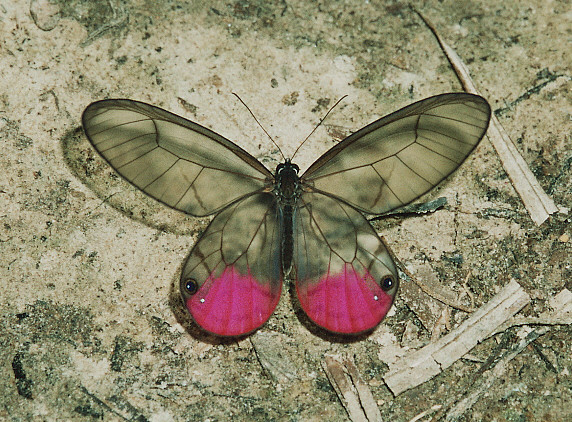
Introduction
One of the many great pleasures of studying neotropical butterflies, as opposed to those from other regions of the world, is that each species has an obvious personality. Some such as the Cithaerias Phantoms taunt the butterfly photographer, allowing him to approach closely, but never quite close enough. He crawls about on the forest floor and gets caught up in tangles of thorny branches, while acquiring souvenirs in the form of excruciatingly painful bites from chiggers and bullet ants. Just as he gets within range of the butterfly a mosquito lands on his ear and inflicts a bite.
As he attempts to compose a photograph it inflicts another bite, but he endures the agony because he is just about to release the shutter button and capture an image of one of the most elusive and beautiful butterflies in the rainforest. At this precise and very carefully anticipated moment in time the Cithaerias casually takes flight. It glides across the forest floor, weaving in and out among the low vegetation, and resettles a couple of metres further from the trail. Foolishly the photographer follows it, as the Paradise Phantom plays catch-me-if-you-can, until just before dusk, and after an hour of pursuit it eventually allows him to capture it’s beauty.
With a reasonable image safely in his camera he then struggles painfully to his feet and prepares to make the long trek back to the relative comfort of his camp before darkness falls. At this moment he suddenly realises that he has completely lost his bearings. In every direction the forest looks the same – an impenetrable tangle of prickly stems, full of snakes and venomous spiders. Somehow he has to find his way back. After several minutes of heart-pounding panic he rediscovers the trail, although he has little idea which direction to take on it. At this moment the Cithaerias reappears, settles on the track a couple of metres away and spreads it’s wings, displaying the vivid paradise-pink of it’s hindwings. Ecstasy.
The tribe Haeterini is confined exclusively to the neotropical region. All members of this tribe are elusive crepuscular butterflies which spend their lives skulking deep in the undergrowth. There are 5 genera – Pierella, Pseudohaetera, Haetera, Dulcedo and Cithaerias. All butterflies in the latter 4 genera have rounded transparent wings, with small ocelli at the apex of the hindwings.
There is contention amongst taxonomists as to the true number of species in the genus Cithaerias. Some consider there to be as many as 15 species, but to quote Bernard d’Abrera “it all depends on how you define a species”. The Lamas neotropical checklist ( 2005 ) only lists 5 – pireta ( previously known as menander ), andromeda, phantoma, pyritosa and pyropina.
Cithaerias phantoma is found in Colombia, Ecuador and Peru.
Habitats
This species is found only in deeply shaded areas of primary rainforest, at altitudes between about 200-800m.
Lifecycle
Nothing is known of the lifecycle or foodplants of Cithaerias species. However it is possible to make some educated guesses. The larvae of most Satyrine butterflies feed on monocotyledons ( grasses, palms, bamboos, sedges, rushes, orchids, lilies etc ).
Cithaerias butterflies tend to be associated more strongly with palm than with bamboos or other monocotyledons. The larvae are likely to be similar to those of other Satyrines – slim, cylindrical, dull greenish or brownish in colour, with thin longitudinal stripes along the back and sides, devoid of setae or tubercles, and possessing caudal prongs, and a pair of knob-like projections on the head.
Adult behaviour
The adults are almost always encountered singly. They are denizens of the darkest and dampest recesses of the rainforest, and appear to be very localised. The butterflies are crepuscular in nature – they can sometimes be found in the middle of the day, but are far more often encountered at dusk than at any other time.
The flight is low over the ground, skulking and phantom-like. The wing beats are deep and slow, but the butterfly is capable of moving rapidly if disturbed. It normally settles with the wings closed, and at such times is extremely difficult to locate.
The butterflies tend to remain deep in the undergrowth, but emerge at dusk to feed at rotting palm fruits on the forest floor, or on fluids exuding from decomposing fungi. They remain stationary for long periods, but are easily put up, and if disturbed retreat into the undergrowth. However they are habitual in behaviour, and often return within a few minutes.
